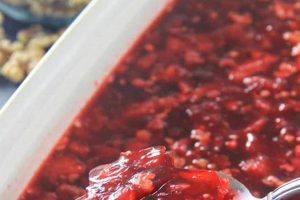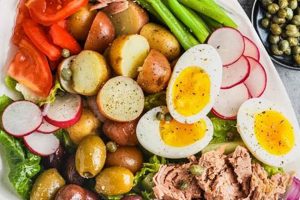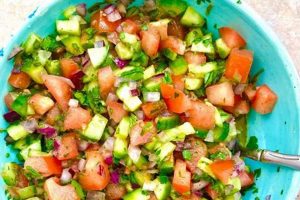Autumnal salads move beyond the light, summery fare of simpler greens and vinaigrette. They embrace the season’s bounty of hearty vegetables, fruits, nuts, and cheeses. Imagine a bed of crisp kale massaged with a maple-Dijon dressing, topped with roasted butternut squash, toasted pecans, crumbled goat cheese, and dried cranberries. This exemplifies the shift towards richer flavors and textures characteristic of the season.
These salads offer a delicious way to enjoy seasonal produce at its peak flavor. Incorporating in-season ingredients not only maximizes taste but also supports local farmers and reduces environmental impact. Historically, autumn has been a time of harvest, and these salads reflect that tradition by showcasing the abundance available before winter. They provide a nutritional bridge between summer’s lighter offerings and the heavier dishes often associated with the holiday season.
The following sections will delve deeper into specific ingredient pairings, dressing options, and techniques for creating balanced and flavorful autumn salads. Further exploration will include variations suitable for different dietary needs and preferences, offering a diverse range of options for enjoying the flavors of fall.
Tips for Crafting Autumnal Green Salads
Creating a successful autumn salad involves thoughtful consideration of ingredients, textures, and flavors. These tips offer guidance for composing balanced and satisfying seasonal salads.
Tip 1: Embrace Seasonal Greens: Move beyond basic lettuce. Consider kale, spinach, arugula, or radicchio as a base. These robust greens hold up well to heartier toppings and dressings.
Tip 2: Roast Root Vegetables: Roasting root vegetables like butternut squash, sweet potatoes, or beets intensifies their sweetness and adds a warm element to the salad.
Tip 3: Incorporate Crunchy Elements: Toasted nuts, seeds, or croutons provide textural contrast and enhance the overall sensory experience.
Tip 4: Explore Autumnal Fruits: Apples, pears, and pomegranates contribute sweetness, tartness, and visual appeal. Consider dried cranberries or figs for added depth of flavor.
Tip 5: Don’t Neglect Protein: Grilled chicken or fish, roasted chickpeas, or crumbled cheese add substance and create a more complete meal.
Tip 6: Balance Flavors with Dressings: Opt for dressings that complement the other ingredients. Maple-Dijon vinaigrette, apple cider vinaigrette, or balsamic glaze work well with autumnal flavors.
Tip 7: Consider Temperature Contrast: Combining warm roasted vegetables with cool greens creates an intriguing interplay of temperatures and textures.
By following these guidelines, one can compose salads that showcase the best of autumn’s produce while offering a satisfying and nutritious meal.
These tips provide a foundational understanding of constructing delicious autumnal salads. The following section offers specific recipe examples for practical application of these concepts.
1. Seasonal Greens
Seasonal greens form the foundation of compelling autumn salads. While lighter lettuces dominate summer salads, fall calls for heartier varieties that can stand up to robust flavors and heavier toppings. The choice of greens significantly impacts the overall texture and flavor profile of the salad. For example, kale offers a slightly bitter and earthy flavor that pairs well with sweet and savory ingredients, while spinach provides a milder backdrop for showcasing bolder components. Other options like arugula, radicchio, or mizuna contribute peppery or slightly bitter notes, further diversifying flavor possibilities.
Selecting greens based on seasonal availability ensures optimal flavor and nutritional value. Locally sourced, in-season greens offer peak freshness and minimize environmental impact. For example, fall varieties of kale and spinach tend to have a deeper flavor and richer texture compared to their summer counterparts. Utilizing these seasonal variations allows for a more authentic and flavorful autumn salad experience. This approach also supports local agriculture and promotes sustainable food practices.
Understanding the characteristics of various seasonal greens allows for strategic ingredient pairings. The robust nature of kale can handle richer dressings and heavier toppings like roasted vegetables and nuts, while more delicate greens like spinach might be better suited for lighter vinaigrettes and delicate fruits. Matching greens to other ingredients creates a balanced and harmonious flavor profile, crucial for a successful autumn salad. This awareness elevates the salad from a simple dish to a culinary expression of seasonal flavors.
2. Roasted Vegetables
Roasted vegetables represent a cornerstone of fall green salad recipes, offering depth of flavor, textural complexity, and visual appeal. The roasting process caramelizes natural sugars, intensifying sweetness and creating nuanced flavors often absent in raw vegetables. This Maillard reaction, a chemical process between amino acids and reducing sugars, contributes to the characteristic browning and rich flavor development of roasted vegetables. For instance, butternut squash, when roasted, transforms from mildly sweet to intensely flavorful with a nutty undertone. Similarly, Brussels sprouts, often perceived as bitter when raw, develop a subtle sweetness and satisfying crispness when roasted. This transformation elevates simple vegetables into compelling salad components.
The inclusion of roasted vegetables in fall salads provides a crucial link to the season’s harvest. Root vegetables, such as carrots, beets, and sweet potatoes, reach peak maturity in autumn and lend themselves particularly well to roasting. Their earthy sweetness complements the robust flavors of fall greens like kale and spinach. Furthermore, the warmth of roasted vegetables contrasts pleasingly with the cool crispness of the greens, creating a multi-sensory experience. Consider a salad with roasted delicata squash, pecans, and crumbled goat cheese atop a bed of baby spinach; the interplay of textures and temperatures elevates the salad beyond a simple combination of ingredients.
Effective utilization of roasted vegetables in fall salads hinges on understanding optimal roasting techniques and flavor pairings. Proper roasting requires attention to temperature, cooking time, and seasoning. Over-roasting can result in dry, mushy vegetables, while under-roasting fails to develop the desired depth of flavor. Balancing flavors is also critical. The sweetness of roasted root vegetables can be offset by the sharpness of a vinaigrette or the saltiness of a cheese like feta or parmesan. A well-composed fall salad showcases the versatility of roasted vegetables, transforming them from a side dish into a star ingredient.
3. Crunchy Additions
Crunchy additions contribute significantly to the overall appeal of fall green salads, providing textural contrast and enhancing sensory experience. These elements introduce a counterpoint to the softer textures of greens and roasted vegetables, creating a more dynamic and satisfying mouthfeel. Consider the interplay between the crispness of toasted pecans and the tender texture of roasted butternut squash in a kale salad the contrasting textures elevate the dish beyond a simple combination of ingredients. This textural diversity keeps the palate engaged, making each bite more interesting. Furthermore, crunchy additions often introduce another layer of flavor, complementing the existing components of the salad. Toasted pepitas, for example, offer a subtle nuttiness that pairs well with the sweetness of roasted sweet potatoes and the peppery bite of arugula.
Several options exist for incorporating crunch into autumnal salads. Nuts, such as pecans, walnuts, and almonds, offer a rich, satisfying crunch and a dose of healthy fats. Seeds, like pumpkin or sunflower seeds, provide a lighter, more delicate crunch and a subtle nutty flavor. Croutons, whether homemade or store-bought, contribute a satisfying crispness and can be flavored to complement the other salad ingredients. Even crispy roasted chickpeas can serve as a crunchy topping, adding a boost of protein and a unique savory element. The choice of crunchy addition should complement the other flavors and textures in the salad, creating a balanced and harmonious whole. For instance, a salad featuring roasted apples and a maple-vinaigrette might benefit from the addition of candied walnuts, while a salad with roasted beets and goat cheese might be enhanced by toasted pumpkin seeds.
Strategic use of crunchy additions allows for customization and personalization of fall green salads. Consider dietary restrictions and preferences when selecting these components. Individuals with nut allergies can opt for seeds or croutons, while those seeking a lower-fat option might choose roasted chickpeas over nuts. The versatility of crunchy additions ensures that individuals with diverse dietary needs can enjoy the textural and flavorful benefits they bring to autumnal salads. Ultimately, thoughtfully incorporating crunchy elements elevates these salads from simple to sophisticated, demonstrating a nuanced understanding of flavor and texture interplay.
4. Autumnal Fruits
Autumnal fruits offer a crucial dimension to fall green salads, contributing sweetness, tartness, and textural complexity. These fruits, harvested at their peak ripeness, provide a welcome contrast to the savory elements of the salad. The interplay of sweet and savory flavors creates a balanced and nuanced taste profile, characteristic of well-composed autumnal dishes. Apples, with their crisp texture and varying degrees of sweetness and tartness, pair well with heartier greens like kale and earthy cheeses such as goat cheese. Pears offer a softer texture and a delicate sweetness that complements the bitterness of arugula and the richness of walnuts. Pomegranates contribute a burst of juicy tartness and visual appeal, enhancing both the flavor and aesthetic of the salad. Integrating these seasonal fruits not only elevates the flavor profile but also provides essential vitamins and antioxidants.
Specific examples illustrate the practical application of autumnal fruits in salad recipes. A salad featuring roasted butternut squash, crumbled goat cheese, and sliced apples showcases the harmonious blend of sweet, savory, and earthy flavors. The crispness of the apple provides a textural counterpoint to the soft squash and creamy cheese. Alternatively, a salad combining arugula, sliced pears, candied walnuts, and gorgonzola offers a more complex flavor profile, balancing the peppery arugula with the sweet pear, the rich cheese, and the candied nuts. These examples demonstrate the versatility of autumnal fruits and their ability to enhance the overall dining experience.
Understanding the role of autumnal fruits in fall green salads enables the creation of balanced, flavorful, and visually appealing dishes. Successful integration involves considering the fruit’s texture, sweetness, and acidity, and pairing it with complementary ingredients. Challenges may arise in balancing flavors and ensuring the fruit maintains its texture and freshness. Proper storage and handling of these delicate fruits are essential to prevent spoilage and maintain optimal quality. Ultimately, the thoughtful incorporation of autumnal fruits elevates the fall green salad from a simple side dish to a sophisticated culinary creation, reflecting the season’s bounty.
5. Protein Choices
Protein plays a vital role in transforming a fall green salad from a side dish into a satisfying main course. The inclusion of protein not only adds nutritional value but also contributes to a more balanced and complete meal. Careful selection of protein complements the other seasonal ingredients, enhancing the overall flavor profile and textural complexity of the salad.
- Lean Meats:
Grilled or roasted chicken, turkey, or fish offer lean protein options that pair well with the robust flavors of fall. Chicken breast, for example, provides a neutral canvas that absorbs the flavors of the dressing and other salad components. Roasted salmon adds richness and healthy fats, complementing the earthy notes of roasted root vegetables and the bitterness of greens like kale. The key is to choose lean protein sources that won’t overpower the delicate flavors of the other ingredients.
- Legumes:
Legumes such as chickpeas, lentils, and black beans provide plant-based protein and fiber, contributing to a heartier and more nutritious salad. Roasted chickpeas offer a satisfying crunch and a nutty flavor that complements roasted vegetables and fall spices. Lentils, with their earthy flavor, pair well with vinaigrette dressings and hearty greens. The versatility of legumes allows for diverse flavor combinations and caters to various dietary preferences.
- Cheese:
Cheese contributes not only protein but also creaminess, saltiness, and depth of flavor. Crumbled goat cheese adds a tangy complexity that complements the sweetness of roasted butternut squash and the earthiness of beets. Feta cheese provides a salty, briny counterpoint to the peppery bite of arugula and the sweetness of dried cranberries. Hard cheeses like parmesan, shaved or grated, contribute a nutty, savory element that enhances the overall flavor profile. The choice of cheese should consider the other ingredients and the desired balance of flavors.
- Nuts and Seeds:
While primarily considered crunchy additions, nuts and seeds also contribute a modest amount of protein and healthy fats. Toasted pecans, walnuts, or almonds provide a satisfying crunch and complement the sweetness of roasted vegetables and fruits. Pumpkin seeds and sunflower seeds offer a lighter crunch and a subtle nutty flavor that enhances the overall texture and flavor profile of the salad. Incorporating nuts and seeds contributes to both the nutritional value and the sensory experience of the salad.
Strategic protein selection elevates fall green salads to main-course status, offering a satisfying and nutritionally complete meal. By thoughtfully combining protein with seasonal greens, roasted vegetables, autumnal fruits, and crunchy additions, one can create a symphony of flavors and textures that celebrate the bounty of fall. The interplay of these elements allows for endless variations and customization, ensuring a delightful and nourishing culinary experience.
6. Complementary Dressings
Complementary dressings represent a crucial element in successful fall green salad recipes. Dressings provide more than simply moisture; they contribute significantly to the overall flavor profile, balancing and unifying the diverse ingredients. A thoughtfully chosen dressing enhances the inherent flavors of seasonal produce, creating a harmonious and cohesive culinary experience. The interplay between the dressing and other components is essential; a heavy, creamy dressing might overwhelm delicate greens and fruits, while a light vinaigrette might not complement the robust flavors of roasted root vegetables. For example, a maple-dijon vinaigrette, with its sweet and tangy notes, complements the earthiness of roasted butternut squash and the bitterness of kale, creating a balanced and flavorful salad. Conversely, a balsamic vinaigrette, with its rich, slightly sweet and acidic profile, enhances the flavors of roasted beets, goat cheese, and candied pecans. Understanding these flavor dynamics is paramount in crafting a successful autumnal salad.
Practical application requires considering the characteristics of various dressings and their compatibility with specific ingredients. Vinaigrettes, typically made with oil and vinegar, offer versatility and can be adapted to complement a wide array of flavor profiles. The type of oil and vinegar used significantly impacts the final flavor; for example, a walnut oil and apple cider vinegar vinaigrette complements the sweetness of roasted apples and the earthiness of pecans. Creamy dressings, while often associated with summer salads, can be adapted for fall by incorporating seasonal flavors. A maple-tahini dressing, for example, adds richness and a nutty sweetness that pairs well with roasted root vegetables and hearty greens. The key lies in achieving balance; the dressing should enhance, not overpower, the flavors of the other ingredients. Overdressing can mask the delicate nuances of seasonal produce, while underdressing can result in a dry, less palatable salad. Achieving the right balance requires careful consideration of the ingredients and their individual characteristics.
Effective dressing selection elevates fall green salads, transforming them from simple combinations of ingredients into cohesive and flavorful dishes. Challenges may arise in balancing the acidity and sweetness of the dressing with the other flavors in the salad. Overly acidic dressings can overwhelm delicate greens, while overly sweet dressings can clash with savory components. Careful tasting and adjustment are crucial to achieving the desired balance. Additionally, the consistency of the dressing must be considered; a thick dressing might weigh down delicate greens, while a thin dressing might not adequately coat the other ingredients. Ultimately, mastering the art of complementary dressings allows for the creation of fall salads that showcase the season’s bounty in a harmonious and delicious manner.
7. Flavor Balance
Flavor balance stands as a cornerstone of successful fall green salad recipes. Achieving this balance requires a nuanced understanding of the interplay between sweet, savory, bitter, acidic, and umami elements. Autumnal ingredients offer a diverse range of flavor profiles; the sweetness of roasted root vegetables, the bitterness of certain greens like kale or radicchio, the earthiness of nuts and seeds, the tartness of fruits like apples and cranberries, and the savory notes of cheese or protein additions. Harmonizing these distinct flavors is crucial. An overly sweet salad can be cloying, while an overly bitter salad can be unappetizing. Consider a salad composed of roasted butternut squash, pecans, and crumbled goat cheese atop a bed of massaged kale. The sweetness of the squash is balanced by the slight bitterness of the kale and the tanginess of the goat cheese, while the pecans provide a nutty, savory element. This interplay of flavors creates a cohesive and satisfying culinary experience.
Practical application of flavor balance principles involves strategic ingredient selection and portion control. Balancing sweetness with bitterness, acidity with richness, and earthiness with brightness are key considerations. For instance, the sweetness of roasted sweet potatoes can be balanced by the peppery bite of arugula and the tanginess of a citrus vinaigrette. The richness of crumbled blue cheese can be offset by the tartness of dried cranberries and the bitterness of radicchio. Portion control also plays a crucial role; too much of any one ingredient can disrupt the delicate balance of flavors. Overly generous portions of roasted vegetables can make a salad heavy and overly sweet, while too much cheese can overpower the other flavors. Careful consideration of ingredient ratios ensures a harmonious and enjoyable culinary experience.
Mastery of flavor balance in fall green salads elevates these dishes from simple assemblages of ingredients to sophisticated culinary creations. Navigating the complexities of flavor profiles requires careful attention to detail and a willingness to experiment. Challenges may arise in balancing contrasting flavors and achieving a cohesive whole. However, the rewards of a well-balanced fall salad are significant, offering a delightful and nuanced culinary experience that showcases the bounty of the season. This understanding allows for the creation of salads that not only nourish but also delight, capturing the essence of autumn on a plate.
Frequently Asked Questions
This section addresses common inquiries regarding the creation and enjoyment of autumnal green salads.
Question 1: How can one prevent fall green salads from becoming soggy?
Soggy salads often result from prematurely dressing the greens. Dress the salad immediately before serving. Another strategy involves layering denser ingredients like roasted vegetables at the bottom, preventing direct contact between the dressing and delicate greens.
Question 2: What are suitable substitutions for individuals with nut allergies?
Seeds, such as pumpkin or sunflower seeds, offer comparable crunch and nutritional benefits. Roasted chickpeas or croutons also provide textural contrast without introducing nuts.
Question 3: Can these salads be prepared in advance?
Components like roasted vegetables and dressings can be prepared ahead of time and stored separately. Combine ingredients just prior to serving to maintain optimal texture and flavor.
Question 4: How can one adapt these recipes for different dietary restrictions, such as vegan or gluten-free diets?
Substitutions allow for adaptation to various dietary needs. Maple syrup or agave nectar can replace honey in dressings. Ensure croutons and other additions are gluten-free when catering to gluten-free diets. Plant-based proteins like chickpeas or tofu can replace animal-based proteins.
Question 5: How can wilted greens be revived?
Submerging greens in ice water for a short period can restore crispness. Ensure greens are thoroughly dried before incorporating them into the salad.
Question 6: How can seasonal ingredients be maximized throughout autumn?
Explore farmers’ markets for the freshest produce. Utilize preservation methods like freezing or canning to extend the enjoyment of seasonal flavors beyond their peak availability.
By addressing these common concerns, individuals can confidently create and enjoy a variety of delicious and satisfying fall green salads throughout the season.
The following section offers a collection of curated recipes demonstrating the principles discussed throughout this article.
Fall Green Salad Recipes
Exploration of fall green salad recipes reveals the potential for culinary creativity using seasonal ingredients. Emphasis on incorporating seasonal greens, roasted vegetables, crunchy additions, autumnal fruits, appropriate proteins, and complementary dressings underscores the multifaceted nature of crafting these dishes. Achieving flavor balance remains paramount, requiring a nuanced understanding of ingredient interactions and careful portion control. Addressing practical considerations, such as preventing sogginess and accommodating dietary restrictions, further enhances accessibility and enjoyment.
Fall green salad recipes offer more than mere sustenance; they represent a celebration of autumn’s bounty. Strategic ingredient selection and thoughtful preparation elevate these dishes to culinary expressions of seasonal flavors. Continued exploration of flavor combinations and innovative techniques promises a vibrant and evolving culinary landscape for autumnal salads.






